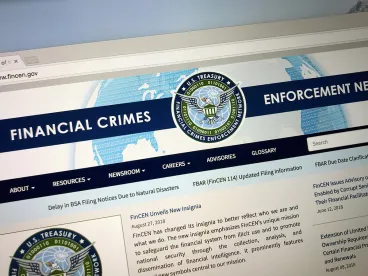Go-To Guide:
- FinCEN has issued proposed rulemaking that would impose a nationwide reporting framework for professionals involved in real estate closings and settlements (such as settlement agents, title insurance agents, escrow agents, and attorneys) (collectively, Reporting Persons), requiring them to report to FinCEN information about non-financed (i.e., all-cash) transfers of residential real estate involving legal entities or trusts.
- Information would be reported in a “Real Estate Report” that would provide FinCEN with, among other things, beneficial ownership information of the legal entity or trust to which the residential real property is transferred (transferees), information about individuals representing the transferee, information about the person that transfers the residential real property, and identification of the property being transferred.
- Reporting Persons would not need to maintain a separate anti-money laundering (AML) program.
- Written comments on the NPRM must be submitted to FinCEN by April 16, 2024.
Background
The U.S. Department of the Treasury’s Financial Crimes Enforcement Network (FinCEN) has long recognized non-financed (i.e., “all-cash”) transfers of residential real estate as susceptible of money laundering because these methods of payment tend to evade scrutiny by financial institutions subject to the Bank Secrecy Act of 1970 (BSA) and anti-money laundering (AML) program obligations and subject to Suspicious Activity Report (SAR) filing requirements.
On Feb. 7, 2024, FinCEN issued a Notice of Proposed Rulemaking (NPRM) that, if adopted as written, would require certain persons involved in real estate closings and settlements (collectively, Reporting Persons) to (A) submit a streamlined version of a SAR, referred to in the NPRM as a “Real Estate Report” and (B) maintain a record of all Real Estate Reports filed, together with a copy of any form signed by the transferee or the person representing the transferee, certifying to the best of their knowledge that the transferee’s beneficial ownership information is correct.
The NPRM would replace FinCEN’s current Residential Real Estate Geographic Targeting Order (GTO) program, which requires title insurance companies to file reports and maintain records identifying the beneficial owners of legal entities that make certain non-financed purchases of residential real estate in select metropolitan areas in the United States. The NPRM, if adopted, would provide for a nationwide reporting framework.
Reportable Transfers of Residential Real Property
The NPRM identifies as “reportable transfers” the non-financed transfers of any ownership interest in residential real property to a transferee entity or transferee trust. The terms “transferee entity” or “transferee trust” are broadly defined to encompass various legal entities used for property ownership such as limited liability companies, corporations, partnerships, estates, associations, and trusts (together, Transferee Entities and Transferee Trusts).
Certain types of transfers are exempt from the reporting requirements, including (A) transfers involving an easement; (B) transfers that occur as the result of the death of a property owner; (C) transfers that occur as the result of a divorce; and (D) transfers that are made to a bankruptcy estate.
Reporting Persons
Under the NPRM, Reporting Persons would generally include settlement agents, title insurance agents, escrow agents and attorneys, so long as they perform a closing or settlement function for the non-financed sale or transfer of residential real property, irrespective of purchase price, to foreign or domestic Transferee Entities and Transferee Trusts.
Only one Reporting Person would be required to file a Real Estate Report for any given reportable transfer. The NPRM provides two methods to identify the Reporting Person:
A. Cascade Framework: The “cascade” framework is outlined in the NPRM as follows:
1. In the first instance, the reporting obligation would rest with real estate professionals providing certain settlement services at the termination of the settlement process, notably those listed as the closing or settlement agent on a settlement (or closing) statement or, in the event no person is identified, then the person who prepared the closing or settlement statement (and if no person prepared a closing or settlement statement, then the person who files the deed or other instrument transferring ownership of the residential real property).
2. If no person executes the specific settlement functions in the first tier of the cascade, the reporting obligation would fall upon the person who underwrites the title insurance policy associated with the real property transfer.
3. If no person executes the specific settlement functions in the first or second tiers of the cascade, the third tier would require reporting by the person who disburses the greatest amount of funds in connection with the reportable transfer (disbursement may be in any form, including from an escrow account).
4. If no person falls within the first three tiers of the cascade, the reporting person is the person who prepares an evaluation of the title status.
5. Last, should no person be identified in the first four tiers, then the reporting obligation would fall on the person who prepared the deed associated with the reportable transfer.
B. Alternative Framework: Alternatively, a Reporting Person may enter into a written designation agreement with another professional identified in the cascade framework to designate such other person as the Reporting Person.
Timeline to File Real Estate Reports
A Reporting Person would need to file Real Estate Report within 30 calendar days from the date of closing. Under the NPRM, the Reporting Person must keep a copy of the Real Estate Report form, along with a form signed by the transferee or a transferee’s representative, certifying that the transferee’s beneficial ownership information is correct.
Reportable Information
A Real Estate Report must include the following:
A. Information about the Reporting Person and transferor (e.g., seller), including name, address, and a unique identifying number;
B. Beneficial ownership information of the Transferee Entity/Transferee Trust receiving the property, and identifying information of each beneficial owner (including name, address, and a unique identifying number);
C. Information about individuals representing the Transferee Entity/Transferee Trust;
D. Information about the residential real property being sold or transferred, including the address; and
E. Information concerning payments made, including total consideration paid, method of payment and the accounts and financial institutions used for each payment and, if the payor is anyone other than the Transferee Entity or Transferee Trust, the name of the payor on the payment form.
Beneficial Owner Defined
For Transferee Entities, the definition of “beneficial owner” is the same as the definition used under FinCEN’s Beneficial Ownership Reporting Rule, i.e. a beneficial owner of a Transferee Entity is “any individual who, directly or indirectly, either exercises substantial control over the [T]ransferee[E]entity or owns or controls at least 25% of the ownership interests of the [T]ransferee [E]ntity” on the date of closing.
A beneficial owner of a Transferee Trust is defined as “any individual who, at the time of the real estate transfer to the trust (A) is a trustee; (B) otherwise has authority to dispose of transferee trust assets, such as may be the case with a trust protector; (C) is a beneficiary who is the sole permissible recipient of income and principal from the transferee trust or who has the right to demand a distribution of, or to withdraw, substantially all of the assets of the transferee trust; (D) is a grantor or settlor of a revocable transferee trust; or (E) is the beneficial owner of a legal entity or trust that holds one of the positions described in (A)–(E), taking into account the exceptions that apply to transferee entities and transferee trusts.”
Next Steps
Written comments on the NPRM must be submitted to FinCEN by April 16, 2024. The NPRM proposes an effective date of one year from the date the final rule is issued.






 />i
/>i
